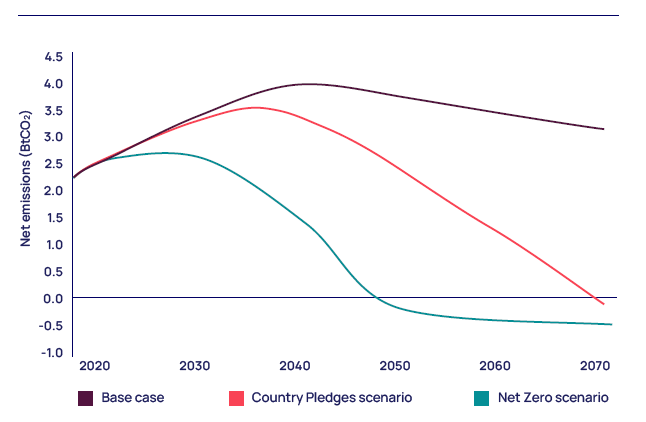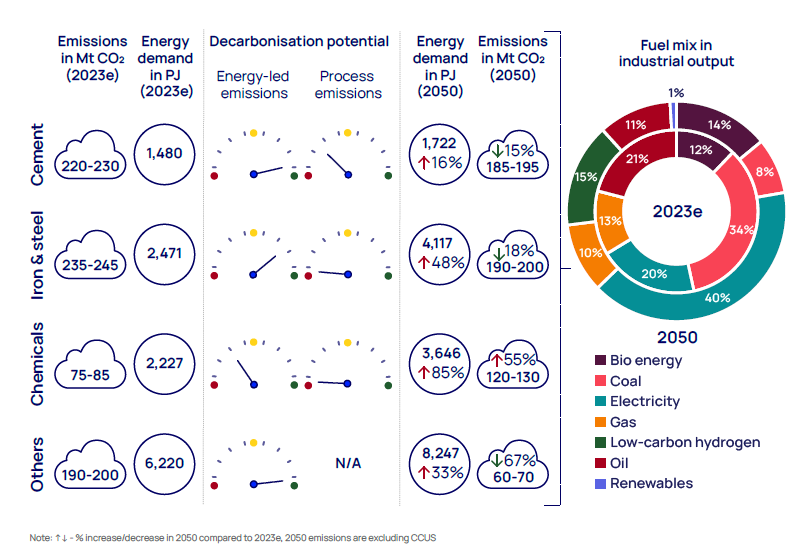Get in touch
-
Mark Thomtonmark.thomton@woodmac.com
+1 630 881 6885 -
Hla Myat Monhla.myatmon@woodmac.com
+65 8533 8860 -
Chris Bobachris.boba@woodmac.com
+44 7408 841129 -
Angélica Juárezangelica.juarez@woodmac.com
+5256 4171 1980 -
BIG PartnershipWoodMac@BigPartnership.co.uk
UK-based PR agency
India has a chance to reach net zero by 2050, two decades ahead of its pledge
Wood Mackenzie’s Net Zero scenario presents a radical redesign of India’s energy sector, making it a US$13 trillion economy in 2050
4 minute read
NEW DELHI/LONDON/HOUSTON, 18 January 2024 – India has a unique opportunity to become a leading low-carbon economic powerhouse by 2050, according to a new Horizons report from Wood Mackenzie. Its net zero 2050 scenario explores how India can achieve decarbonisation and become a US$13 trillion economy by investing in clean energy technologies and market-driven policies.
Currently the world's third-largest emitter, India's energy system relies heavily on fossil fuels. However, by 2032, India is expected to become the world's third-largest economy, up from fifth today. The report, titled "Chance of a lifetime: can India show the developing world a unique path to net zero?" presents a radical approach for India to achieve net zero while also industrialising and supporting its fast-growing population.
Prakash Sharma, vice president, scenarios and technologies research at Wood Mackenzie said, “Our analysis of how India can reach net zero by 2050 – two decades ahead of its current pledge – is highly ambitious, extremely challenging and without precedent ‒ but it is possible. Infrastructure investment and maximising its unique human talent are key tenets of its transition. If successful, India will offer a different energy transition pathway for other developing countries.”
India’s energy sector net CO2 emissions pathways

Source: Wood Mackenzie Energy Transition Service
Electrifying India
The Indian government’s Panchamrit initiative, first presented at COP26 in 2021, aims to promote the rapid development of renewable energy. The comprehensive five-point strategy includes setting an ambitious target of generating 500 GW of non-fossil-fuel electricity by 2030, equivalent to Europe’s current combined solar and wind capacity. India must nearly triple its non-fossil-fuel capacity in just six years to achieve this goal.
“Rapid growth in renewables is essential to electrifying India’s energy economy,” said Roshna N, research analyst, scenarios and technologies research at Wood Mackenzie. “Currently, the country is ranked fourth globally in installed renewable capacity, contributing to about 43% of the total power generation capacity, including hydro. If India can fulfil 50% of its energy needs with non-fossil fuel sources, it could lead to a cumulative reduction of 1 billion tonnes of carbon emissions by 2030,” Roshna added.
To align with Wood Mackenzie’s 2050 net zero scenario, India must increase its non-fossil fuel electricity generation to almost 80% by 2050. The country must establish low-cost domestic supply chains for large-scale solar and wind power and off-grid and decentralised renewable energy systems to accomplish this.
Taking emerging technologies mainstream
India faces the unique challenge of decarbonising far newer and early-life production units than other major economies. This presents an opportunity for industrial growth through low-carbon technology manufacturing and supply chain development earlier in the investment cycle.
Bioenergy: India has a vast potential for bioenergy from biomass residue, around 750 million tonnes annually. Bioenergy usage needs to shift from residential to industrial and transport sectors. According to Wood Mackenzie’s 2050 scenario, biofuels can potentially displace up to 0.5 million barrels per day of transport oil demand.
Nuclear: India has the potential to become a leader in small modular reactors (SMRs) of 300 MW or less, due to its scientific capabilities and experience in indigenous pressurised heavy water and submarine reactors. Under the Wood Mackenzie’s Net Zero 2050 scenario, the country would require 120 GW of nuclear energy.
Green hydrogen: India’s high solar irradiance (1,200-2,300 kilowatt hour/m2/year) and wind speeds (4-6 m/s), makes its green hydrogen cost effective to abate difficult sectors. “By 2030, hybrid onshore wind and solar could bring down the levelised cost of hydrogen (LCOH) to US$4.3/kg H2, the second lowest in Asia after China”, said Roshna.
Carbon Capture, Utilisation and Storage (CCUS): India could use captured CO2 for urea and methanol production to decarbonise its mammoth fertiliser and heavy-duty mobility sectors, respectively. New industries can emerge with timely government incentives, as more than a gigatonne of CCUS capacity is needed by 2050.
Tackling India’s hard-to-abate sectors
Unique among the world’s major economies, India’s development combines its services-led economy with a growing emphasis on manufacturing. India risks exacerbating a worsening emissions profile. Wood Mackenzie’s Net Zero 2050 scenario calls for economic growth tied to sustainability, especially in hard-to-abate manufacturing sectors – including cement, iron, steel, and chemicals – which combined account for three-quarters of India’s total industrial emissions.
Industrial emissions and energy demand outlook in our Net Zero 2050 scenario

Source: Wood Mackenzie Energy Transition Service
India is in the process of implementing a compliance carbon market along with a voluntary mechanism. Net Zero 2050 requires the carbon price to reach US$154/tonne of CO2 – a tough task for India’s price sensitive economy. A transparent carbon pricing mechanism can incentivise companies to invest in CCUS, green hydrogen, renewables and bioenergy, which may otherwise seem unviable due to high initial capital costs.
“Our India Net Zero 2050 scenario requires decades of consistent and unwavering political leadership. To achieve this, India must seek global support and use its soft power and diplomatic influence to persuade wealthier countries to invest in its vision. Building strong partnerships is crucial,” said Sharma. “While our base case and Net Zero 2050 scenario highlight the scale of the challenge, they should serve as a catalyst rather than an obstacle. India now has a once-in-a-lifetime opportunity to decarbonise its economy rapidly and it should take it.”





